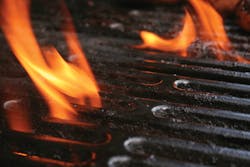Off-the-Job Safety: Cancer Experts Issue Warning on Grilling Safety
In time for the start of grilling season, experts at the American Institute for Cancer Research (AICR), an organization that studies the impact of lifestyle on cancer risk, issued a warning about the hidden health hazards of cookouts and campfires.
“Research now shows that diets high in red and processed meat increase risk for colon cancer,” said AICR registered dietitian Alice Bender. “And grilling meat – red or white – forms potent cancer-causing substances. But by keeping five simple steps in mind, it’s possible to make this summer’s backyard grilling both healthier and more flavorful.”
Step One: Mix up the meat. The first thing to understand is that what meat you choose to grill is just as important as how you grill it. However you prepare it, diets high in red meat (beef, pork and lamb), are linked to increased risk for colon cancer. Even small amounts of processed meat (hot dogs, sausages) cause risk to inch up.
Step Two: Marinate. Charring and cooking meat, poultry and fish under high heat causes compounds called heterocyclic amines (HCAs) and polycyclic aromatic hydrocarbons (PAHs) to form. These substances have shown the ability to damage our DNA in ways that make cancer more likely. Studies have shown that marinating meat, poultry and fish for at least 30 minutes can reduce the formation of HCAs.
Step Three: Partially pre-cook. PAHs are deposited onto the meat by smoke. So by reducing the amount of time meat spends exposed to flame by first partially cooking it in a microwave, oven or stove, you can reduce the amount of PAHs you ingest.
Step Four: Stay low. Cook meat over a low flame to reduce the formation of HCAs and PAHs, and help keep charring to a minimum.
Step Five: Throw some color on the grill. Colorful vegetables and fruits contain fiber, vitamins and naturally occurring compounds called phytochemicals. These substances add anti-cancer action to your backyard bash. And by loading up on plant foods, you can cut back on red and processed meats.
About the Author

Sandy Smith
Sandy Smith is the former content director of EHS Today, and is currently the EHSQ content & community lead at Intelex Technologies Inc. She has written about occupational safety and health and environmental issues since 1990.
